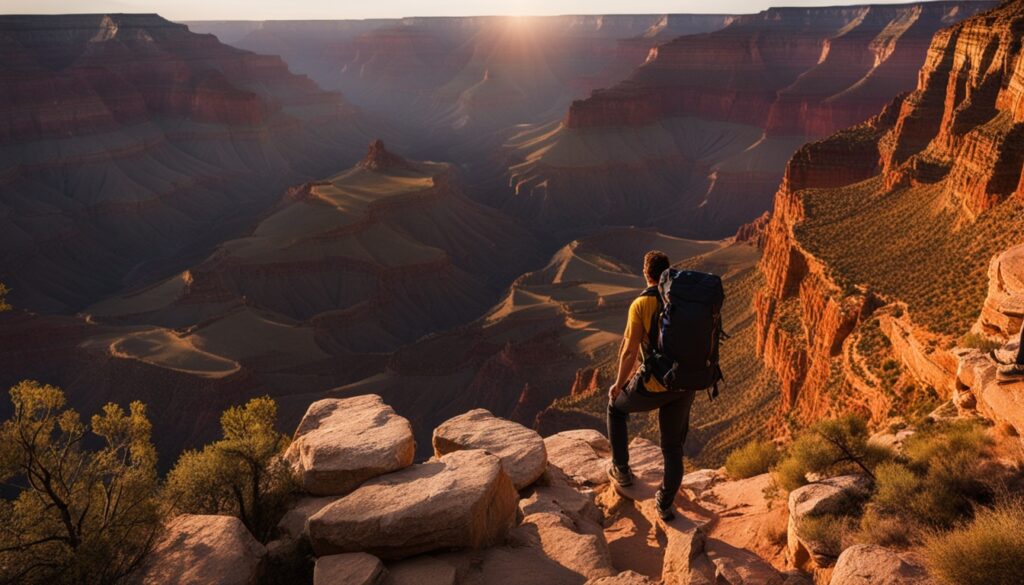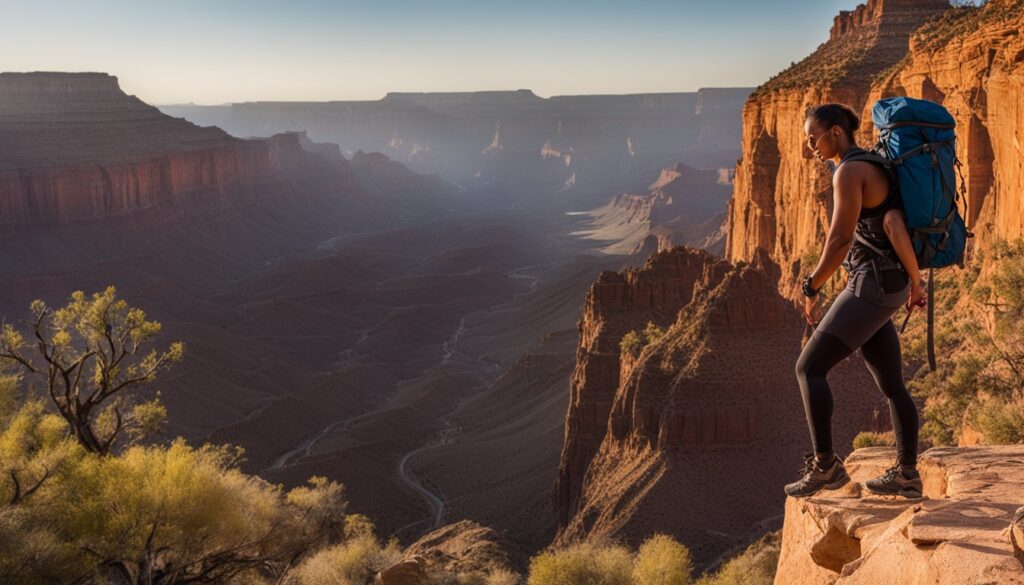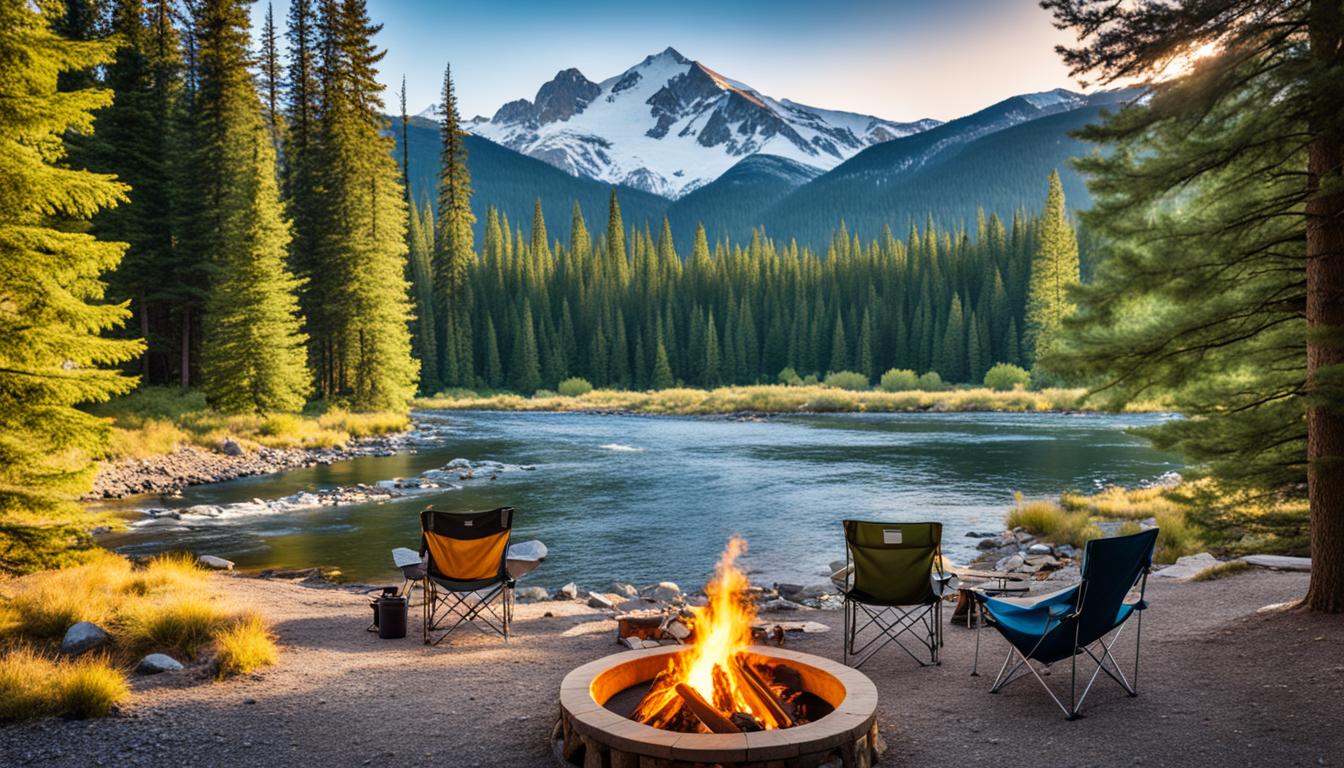Get ready to be amazed – the Grand Canyon Rim to Rim hike is a massive 24 miles long. It drops 6,000 feet from the North Rim and then goes up 4,500 feet to the South Rim. Even top hikers need tough training to make it through this incredible place. This guide will show you how to get ready for a Grand Canyon hike. We’ll talk about the special challenges you’ll face and the best ways to prepare for them.
Key Takeaways
- The Grand Canyon has steep trails, thin air, and big changes in temperature. It’s one of the toughest places to hike in the world.
- It’s crucial to train right to handle the tough hike. This includes building up your endurance, getting stronger, and getting used to high altitudes.
- Choosing the right gear and packing the essentials is key for a successful and comfy hike in the Grand Canyon.
- Talking to experienced guides can give you great advice and help with planning your rim-to-rim hike.
- Having a detailed training plan that fits the Grand Canyon’s unique challenges is essential to beat this hiking challenge.
Understanding Grand Canyon Hiking Conditions
Hiking in the Grand Canyon is a big challenge. You need to be well-prepared and have a lot of endurance. The trails are steep, the air is dry, and the temperatures change a lot. It’s important to know these things to have a safe and fun trip.
Steep Trails
The Grand Canyon’s trails are very steep. The North Rim is 8,000 feet above sea level, the South Rim is 7,000 feet, and the bottom is around 2,400 feet. This means hikers have to climb a lot, which is hard work.
Low Humidity
The air in the Grand Canyon is very dry, with humidity between 10 to 30 percent. This makes sweat evaporate fast, so it doesn’t cool you down much. Hikers need to drink lots of water to stay hydrated.
High Elevation
Being over 5,000 feet up can make you sick. You might get high-altitude sickness, which is serious. It’s important to watch out for this and get help if you need it.
Temperature Differences by Elevation and Time
The temperature in the Grand Canyon changes a lot because of the different heights. Going up 1,000 feet can make it 5.5 degrees Fahrenheit hotter. So, the North Rim is cooler than the bottom, which can be really hot.
Long Distances
Hikes in the Grand Canyon can be very long. A trip to the river and back is 15 to 27 miles. Going from one rim to the other is 21 to 24 miles. You need to be ready for this to have a good time.
“The Grand Canyon is a natural wonder that challenges even the most experienced hikers. Proper preparation and an understanding of the unique conditions are essential for a safe and rewarding adventure.”
Required Gear for Grand Canyon Hikes
Getting ready for a grand canyon hiking gear trip means thinking about what you need to bring. You’ll face tough terrain, need to stay hydrated, and protect yourself from the weather. The 10 essentials for grand canyon hikes are key for a safe and successful trip.
When packing for the grand canyon hiking gear, think about the weight of your backpacking gear for grand canyon. The trails are steep, the air is dry, and the elevation is high. You’ll need to carry a heavy backpack comfortably. Aim to keep your backpack’s weight, minus what you’re wearing, around 28 pounds.
The 10 essentials you must pack include navigation tools, a headlamp, and sun protection. Don’t forget first aid supplies, a knife, and fire-starting gear. You’ll also need a shelter, extra food, extra water, and extra clothes. Remember to pack a backpack, sleeping gear, cooking equipment, and personal hygiene items too.
| Gear Category | Total Weight (oz) |
|---|---|
| Clothing (Worn) | 82.10 |
| Other Clothing | 64.40 |
| Storage Gear | 54.30 |
| Sleeping and Shelter | 78.15 |
| Hydration and Cooking | 14.70 |
| Miscellaneous and Electronics | 27.40 |
| Personal and Hygiene | 6.20 |
| 10 Essentials/Repair Kit | 25.90 |
| Miscellaneous | 1.20 |
| Consumables | 175.55 |
| Base Weight | 272.25 |
| Total Carried Weight | 447.80 |
Choosing the right gear and preparing well is key for a great grand canyon hiking gear trip. Knowing what you need and packing it will help you tackle the Grand Canyon’s challenges.
How to Train for Hiking Grand Canyon
Getting ready for a hike in the Grand Canyon means training your body for its unique challenges. You’ll face steep trails, big changes in elevation, and changing temperatures. Your training should get you ready for these demands.
Hiking Mountains and Difficult Trails
Find hikes with mountains and tough trails that have at least 1,000 feet of elevation change. This kind of training will make your muscles stronger and boost your heart health. It prepares you for the constant ups and downs of the Grand Canyon.
Practicing on Stairs
Stair-climbing is great for training. It works your hamstrings, glutes, and calves, which are important for hiking the Grand Canyon. Try to climb stairs for 45-60 minutes a day to build up your endurance.
Improving Cardio Endurance
Being able to breathe and move easily for long periods is key for the Grand Canyon. Try running, swimming, cycling, or jump roping to get your heart rate up. Slowly increase how long and hard you work out to get your body ready.
Incorporating Yoga
Yoga is also good for training. It helps with flexibility, breathing, and strength, all useful for hiking. Focus on poses like lunges, squats, and core exercises to target the right muscles.
Training with Gear
Use the same backpack you’ll have on your hike during training. Start with a pack that’s about one-third of your body weight. Then, slowly add more weight until you’re carrying the full pack for at least three weeks before your trip.
Using these training methods will help you face the Grand Canyon’s challenges. You’ll be ready for a safe, enjoyable hike.

Training Exercises for Hikers
Getting ready for the Grand Canyon’s tough trails is key. Two great exercises can boost your strength and fitness: goblet squats and downhill lunges.
Goblet Squats
Goblet squats are great for the glutes, quads, and hamstrings. These muscles are key for hiking. Hold a dumbbell or kettlebell at your chest and squat deeply, keeping form right. This exercise prepares you for the Grand Canyon’s steep climbs and drops.
Downhill Lunges
Downhill lunges are perfect for getting your quads ready for the Grand Canyon’s steep downs. Stand with one foot ahead, then bend both knees and hips, keeping your upper body straight. This mimics the controlled way you need to go down the trails. It also works your core and stabilizers for better balance and stability.
Adding these strength training exercises for hikers, leg exercises for grand canyon hikes, and conditioning for descending in grand canyon to your routine will get your body ready for hiking in the Grand Canyon.
YMCA Step Test and Grand Canyon Hike Training Program
Before you tackle the Grand Canyon hike, it’s key to check your heart health. The YMCA Step Test is a great way to see where you stand. It’s easy and shows how fit you are for the big hike ahead.
This test means stepping up and down a 12-inch box for 3 minutes. Then, you measure your heart rate to see how fast it goes back to normal. Do this test before and after your 6-week training to see how much you’ve improved.
Your training should mix strength and cardio exercises. This mix gets your body ready for the Grand Canyon’s tough hike. It boosts your ymca step test for grand canyon hike training and your cardiovascular fitness assessment for grand canyon hikes.
| Training Component | Exercises |
|---|---|
| Strength Training |
|
| Aerobic Training |
|
With this grand canyon hike training program, you’ll get fit and ready for the Grand Canyon. You’ll feel more confident and prepared for the challenge.
“The YMCA Step Test is a simple and effective way to evaluate your current fitness level before embarking on your training program.”

Aerobic Training Programs
Getting ready for the Grand Canyon hike means focusing on your aerobic fitness and heart health. These aerobic training programs will help you build the stamina needed for the tough terrain and long distances of the Grand Canyon.
Aerobic Program A: Steady-State Cardio
This program focuses on long, steady workouts to help you stay active for a long time. Try to do 45-60 minutes of continuous activity like brisk walking, jogging, cycling, or swimming 3-4 times a week. Keep a steady pace to build your aerobic training for grand canyon hikes.
Aerobic Program B: High-Intensity Intervals
This program is all about short, intense workouts to boost your ability to tackle steep hills and bounce back fast. Do 2-3 sessions per week of high-intensity interval training (HIIT), like sprints, hill repeats, or cycling intervals. These exercises will enhance your cardiovascular endurance training for grand canyon.
Aerobic Program C: Backpack Endurance
This program is about getting used to carrying a backpack and hiking shoes for longer distances. Try to increase the distance and time of your weekly hikes, with a loaded backpack 1-2 times a week. This will help build your endurance building exercises for grand canyon hikes.
Combine these aerobic training programs into your Grand Canyon prep to get the fitness and endurance needed for the hike.
“The Grand Canyon is not a hike to be taken lightly. Proper aerobic training is essential to ensure a safe and enjoyable experience.”
Strength Training Programs
Getting ready for a tough Grand Canyon hike means you need endurance and strong muscles, especially in your lower body. This guide offers strength training plans to build the muscles and strength you need for a successful hike.
Strength Program A
Strength Program A targets exercises that prepare your body for hiking with a heavy pack. It includes front step-ups, lateral lunges, and single-leg calf raises. These are done with different pack weights: none, half, and full. These exercises focus on the main muscles used in hiking, helping you build strength training for grand canyon hikes and leg strengthening exercises for grand canyon.
Strength Program B
Strength Program B boosts leg and core strength with exercises like lateral step-ups, walking lunges, and single-leg calf raises. These are also done with different pack weights. They’re designed to backpack training for grand canyon and get your body ready for the steep trails and uneven ground of the Grand Canyon.
| Exercise | Sets | Reps | Weight |
|---|---|---|---|
| Front Step-ups | 3 | 12-15 | Empty Backpack, Half-Pack, Full Pack |
| Lateral Lunges | 3 | 10-12 per side | Empty Backpack, Half-Pack, Full Pack |
| Single-Leg Calf Raises | 3 | 15-20 per leg | Empty Backpack, Half-Pack, Full Pack |
| Lateral Step-ups | 3 | 10-12 per side | Empty Backpack, Half-Pack, Full Pack |
| Walking Lunges | 3 | 10-12 per leg | Empty Backpack, Half-Pack, Full Pack |
Always talk to a fitness expert or doctor before starting any new exercise plan, especially if you have health concerns. It’s important to focus on proper form and gradually increase the difficulty to avoid getting hurt. This will help you reach your goals for the Grand Canyon hike.
Supplemental Training Tips
Along with structured training, other activities can help prepare you for a Grand Canyon hike. Cycling, yoga, and Pilates are great for building strength, flexibility, and balance. These are key for handling the tough terrain of the Grand Canyon.
Remember, flexibility is crucial. Spending time on stretching and mobility exercises can prevent injuries and keep you ready for the hike. Also, focus on your hydration and sodium intake before your trip. Being well-hydrated and replenishing electrolytes is key in the hot, dry conditions of the Grand Canyon.
Always talk to a healthcare professional before starting a new training plan. They can give you advice tailored to your fitness level and health. With these tips and your regular workouts, you’ll be ready to tackle the Grand Canyon’s trails.
FAQ
What is the elevation change in the Grand Canyon?
The Grand Canyon has an elevation change of about a mile from the rim to the canyon floor.
What are the temperature differences in the Grand Canyon?
The Grand Canyon has extreme temperature changes. For every 1,000 feet down, the temperature goes up by 5.5 degrees Fahrenheit.
What are the “10 essentials” for a Grand Canyon hike?
The “10 essentials” for hiking the Grand Canyon include navigation tools, a headlamp, and sun protection. Also, first aid supplies, a knife, and fire-starting equipment are must-haves. Don’t forget a shelter, extra food, extra water, and extra clothing.
How can I train for the steep trails in the Grand Canyon?
To get ready for steep trails, hike mountains and trails with a lot of elevation gain. Aim for trails that go up at least 1,000 feet to build up your climbing strength.
What exercises can help me prepare for the descents in the Grand Canyon?
Doing goblet squats and downhill lunges can strengthen your muscles for going down the Grand Canyon.
How can the YMCA Step Test help me prepare for a Grand Canyon hike?
The YMCA Step Test checks your heart fitness, which is key for a Grand Canyon hike. Do the test before and after your 6-week training to see how you’re improving.
What are the different aerobic training programs for preparing for a Grand Canyon hike?
There are three aerobic training programs. Aerobic Program A is for long, steady workouts. Aerobic Program B is for short, intense activities. Aerobic Program C helps you carry more with your backpack and hiking shoes.
What are the strength training programs for a Grand Canyon hike?
Strength training includes two programs. Strength Program A focuses on exercises like front step-ups and lateral lunges. Strength Program B adds exercises like walking lunges and single-leg calf raises, all with different pack weights.
What other activities can supplement my training for a Grand Canyon hike?
Besides hiking, you can do cycling, yoga, and Pilates to build strength and flexibility. Remember to drink plenty of water and eat enough sodium before your trip.
















